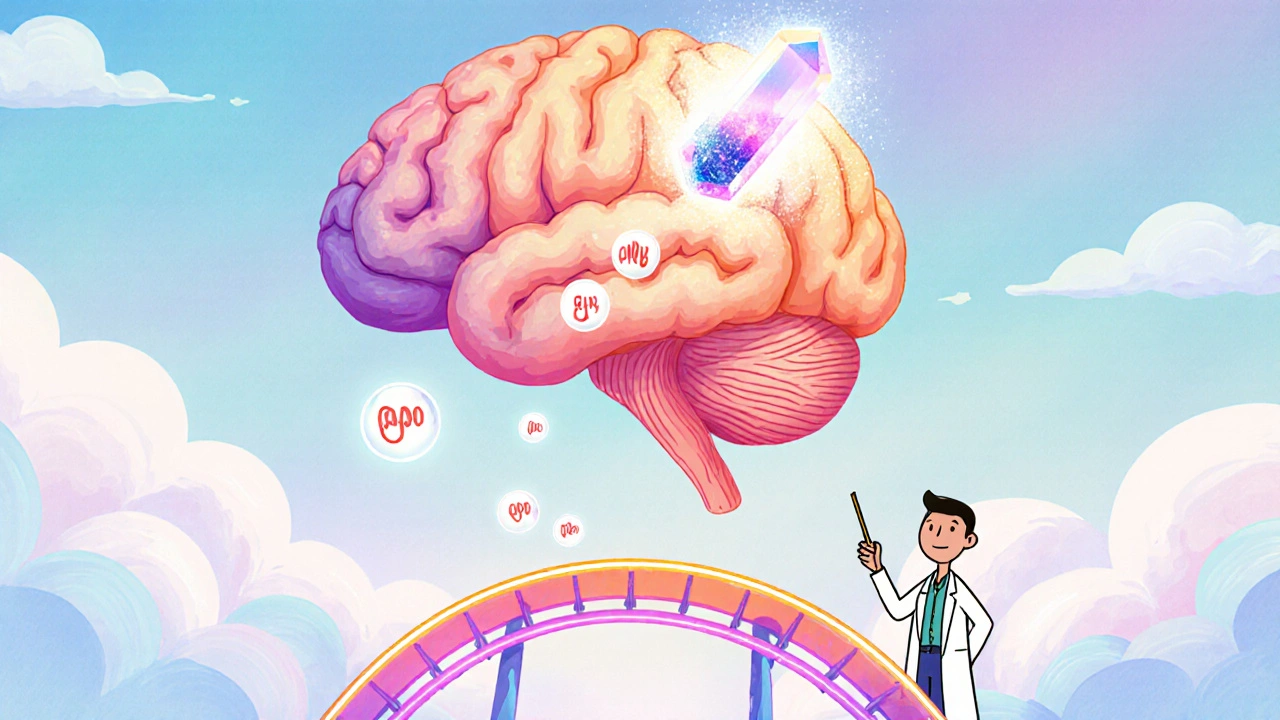Valproic Acid Dosing Calculator
Key Information
The therapeutic window for valproic acid is 50-100 µg/mL for bipolar disorder treatment.
For acute mania, most patients see improvement within 5-7 days of starting therapy.
Regular blood monitoring is critical to maintain therapeutic levels and avoid toxicity.
Important Safety Note: Women of childbearing age must use effective contraception due to teratogenic risks. Baseline liver function tests are required before starting therapy.
Enter your patient information to see recommended dosing
| Dosing Phase | Recommended Dose | Monitoring Schedule |
|---|---|---|
| Initial Dosing | N/A | N/A |
| Adjustment Period | N/A | N/A |
| Maintenance | N/A | N/A |
When someone is diagnosed with Valproic Acid is a broad‑spectrum anticonvulsant that also serves as a powerful mood stabilizer, the big question is whether it can keep the roller‑coaster of Bipolar Disorder under control.
In this guide we’ll break down the science, the clinical evidence, dosage tricks, and the safety checklist you need to know. If you’re a patient, a family member, or a clinician, by the end you’ll understand why valproic acid bipolar treatment works for many people and what red flags to watch for.
- Clear explanation of how valproic acid stabilizes mood
- Evidence‑based dosing recommendations
- Side‑effect profile and monitoring guidelines
- Head‑to‑head comparison with lithium and carbamazepine
- Practical tips you can use today
How Valproic Acid Works
Valproic acid belongs to the Mood Stabilizer class, but its chemistry is rooted in seizure control. The drug increases the availability of GABA (gamma‑aminobutyric acid), the brain’s main inhibitory neurotransmitter, and blocks high‑frequency firing of Sodium Channels. By dampening neuronal excitability, valproic acid smooths out the extreme highs (mania) and lows (depression) that define bipolar disorder.
Two formulations are common: the plain “valproic acid” salt and Sodium Valproate, which is chemically a sodium salt of the same molecule. Both deliver identical therapeutic effects; the choice depends on physician preference and patient tolerance.
Effectiveness for Bipolar Disorder
Clinical trials from the 1990s onward showed that valproic acid rapidly reduces manic symptoms, often within a week of starting therapy. Its efficacy in preventing depressive relapse is more modest, which is why many clinicians pair it with an adjunctive antidepressant or a second mood stabilizer.
Guidelines from the APA Guidelines recommend valproic acid as a first‑line option for acute mania, especially when rapid control is required or when patients cannot tolerate lithium.
One reason valproic acid shines is its broad spectrum: it works for both classic bipolar I (full‑blown manic episodes) and mixed‑state presentations where patients swing between mania and depression in the same day.
Clinical Evidence and Regulatory Status
The FDA approved valproic acid for seizure disorders in 1978 and later extended the indication to bipolar mania in 1995. Since then, meta‑analyses of double‑blind studies have consistently reported a 50‑60% response rate for manic episodes, comparable to lithium but with a faster onset.
Real‑world data from large psychiatric registries in Australia, the United States, and Europe confirm these findings. Patients who start on valproic acid often stay stable for an average of 2.3 years before switching due to side effects or inadequate mood control.

Dosage and Therapeutic Drug Monitoring
Starting doses typically range from 500 mg to 1 g per day, divided into two doses. The goal is to reach a serum concentration of 50-100 µg/mL, measured through Therapeutic Drug Monitoring. Regular blood draws every 1-2 weeks after dose adjustments help keep the level in the therapeutic window and avoid toxicity.
- Begin with 500 mg twice daily.
- Check serum level after 5-7 days.
- If below 50 µg/mL, increase by 250 mg per dose.
- Re‑check after another week.
- Maintain the lowest dose that keeps the level between 50-100 µg/mL and controls symptoms.
Special populations need adjustments. Elderly patients often start 25% lower, while adolescents may require higher per‑kg dosing but demand stricter liver monitoring.
Common Side Effects and Risks
Like any potent medication, valproic acid comes with a safety checklist.
- Hepatotoxicity - liver enzymes can rise, especially in the first six months; baseline and quarterly liver function tests are a must.
- Teratogenic Risk - birth defects, especially neural tube defects, are a serious concern. Women of child‑bearing potential must use effective contraception or consider alternatives.
- Weight gain - average 3-5 kg in the first year; diet counseling helps.
- Gastrointestinal upset - nausea, vomiting, and abdominal cramps are common early on but usually fade.
- Pancreatitis - rare but severe; patients should report severe abdominal pain promptly.
Monitoring guidelines suggest checking liver enzymes, amylase/lipase, and complete blood count at baseline, then every 3 months for the first year, and annually thereafter.
Comparing Valproic Acid with Other Mood Stabilizers
Choosing the right mood stabilizer often feels like picking a teammate for a marathon. Below is a quick side‑by‑side look at the three most common options.
| Stabilizer | Typical Dose | Primary Mechanism | Pros | Cons |
|---|---|---|---|---|
| Valproic Acid | 500 mg-2 g/day | Increases GABA, blocks Na⁺ channels | Fast mania control, good for mixed states | Liver toxicity, teratogenic |
| Lithium | 600 mg-1.2 g/day (target 0.6-1.2 mmol/L) | Modulates intracellular signaling, neuroprotective | Strong evidence for suicide reduction | Kidney issues, narrow therapeutic window |
| Carbamazepine | 200 mg-1.2 g/day | Na⁺ channel blocker, reduces excitatory transmission | Effective for rapid cycling | Skin rash, hyponatremia, drug interactions |
For patients who cannot tolerate lithium’s renal effects or need rapid mania suppression, valproic acid often wins. However, if pregnancy is a possibility, lithium or lamotrigine may be safer choices.
Practical Tips for Patients and Clinicians
- Always schedule a baseline liver panel before the first dose.
- If you’re a woman of child‑bearing age, discuss contraception up front.
- Keep a symptom diary for the first 8 weeks - it helps the prescriber fine‑tune the dose.
- Avoid alcohol, which can increase liver strain.
- Set reminders for blood tests; missing a level check can lead to unnoticed toxicity.
- Ask your doctor about vitamin B9 (folic acid) supplementation if you’re planning a pregnancy.
Clinicians should remember to screen for hepatitis B/C before initiating therapy, particularly in patients with a history of IV drug use or endemic exposure.
Frequently Asked Questions
Can valproic acid be used for bipolar depression?
Valproic acid is most effective for acute mania. For depressive episodes, clinicians often add an antidepressant or switch to a mood stabilizer with stronger antidepressant properties, such as lamotrigine.
How long does it take to see improvement?
Most patients notice a reduction in manic symptoms within 5-7 days. Full stabilization may require 3-4 weeks of dose titration and monitoring.
Is it safe to take valproic acid with other psychiatric meds?
Yes, but drug‑drug interactions are common. Valproic acid can raise levels of lamotrigine and some antipsychotics, so dose adjustments and close lab monitoring are essential.
What should I do if I miss a dose?
Take the missed dose as soon as you remember, unless it’s almost time for the next dose. In that case, skip the missed one and resume the regular schedule - never double‑dose.
Are there natural alternatives to valproic acid?
Lifestyle changes like regular sleep, stress management, and omega‑3 supplementation can support mood stability, but they cannot replace the pharmacologic effect of valproic acid for acute mania.
Understanding the balance between benefits and risks empowers patients to make informed choices and helps clinicians prescribe with confidence. When used correctly, valproic acid remains a cornerstone in the modern treatment arsenal for bipolar disorder.


Comments (6)
Vikas Kumar
India's medical brilliance outshines Western hype, and Valproic should be our first line.
Heather ehlschide
Valproic acid works by boosting GABA and stabilizing neuronal firing, which helps tame manic episodes. The recommended starting dose is 500 mg twice daily, with serum levels targeted between 50‑100 µg/mL. Regular liver function tests are essential, especially in the first six months of therapy. Monitoring ensures you stay within the therapeutic window while minimizing side effects.
Kajal Gupta
Hey folks, just wanted to add that valproic's rapid onset can be a real lifesaver, especially when you need to bring that manic surge down fast. On the flip side, keep an eye on weight gain – it’s like packing extra baggage you didn’t ask for! And don’t forget the teratogenic risks; a solid contraception plan is non‑negotiable for women of child‑bearing age. Bottom line: balance the benefits with vigilant monitoring, and you’ll navigate the storm much smoother.
Zachary Blackwell
What they don’t tell you is that big pharma pushes valproic acid like a Trojan horse, hiding the long‑term neurotoxicity behind glossy trial data. The “fast‑acting” label is a marketing ploy to keep patients dependent while the real side‑effects simmer under the radar. If you dig deeper, you’ll see a pattern of suppressed research on liver damage and cognitive decline. Wake up and question the agenda before you swallow another pill.
prithi mallick
Life’s a dance between the mind and the chemestry that fuels it, and valproic acid is a potent rhythm that can steady the wobble. Yet we must pause and reflect on the ethical weight of prescribing meds that can harm livers, especially in vulnerable populations. Remember, safety isn’t just a checklist; it’s a shared responsibility between doctor, patient, and society. Take the time to discuss folic acid supplementation if pregnancy looms – because prevention is always better than cure.
Michaela Dixon
I have always been fascinated by the way tiny molecules can rewrite the story of a brain in crisis. Valproic acid is like a backstage crew that quiets the chaotic lights of mania and lets the director of mood take control. When you start a patient on 500 milligrams twice daily the first week feels like a gentle sunrise after a thunderstorm. The serum levels you chase, fifty to a hundred micrograms per milliliter, are the hidden gauges that tell you the engine is humming smoothly. If those numbers drift higher you might see the dreaded liver spikes that whisper warnings you cannot ignore. The liver tests you order every few weeks become the honest mirrors reflecting the drug’s true nature. Women of child‑bearing age must wear the armor of contraception because the birth defect risk is a shadow that looms large. Weight gain of three to five kilograms can feel like an unwanted souvenir from the treatment journey. Some patients describe the nausea in the first days as a stubborn gatekeeper that eventually opens. The good news is that most of the gastrointestinal upset fades as the body finds its rhythm. You will also notice that the manic symptoms often bow down within five to seven days like a reluctant performer taking a cue. Depression, however, is a slower beast and may need an extra partner on stage such as lamotrigine or a cautious antidepressant. The key is to keep a symptom diary for at least eight weeks to track the subtle shifts in mood and side effects. In my practice I have seen the kind of transformation that feels like a phoenix rising when the dosage is fine‑tuned with patience. Ultimately the art of using valproic lies in balancing the rapid calm it brings with the diligent watchfulness of labs and lifestyle tweaks.